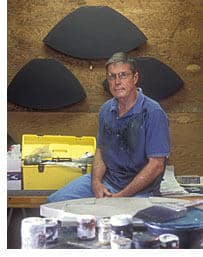Irving Jenkins Biography
Irving Jenkins: Reflections on a Hawai’i Heritage
(Based on the Honolulu Academy of Arts Calendar News – March/April 2004)
 Hawai‘i-born scholar Irving Jenkins (b.1942), celebrated for his publications on Hawaiian furniture and calabashes and most recently Lord of the Hawaii Rain, a book about the contents of the Forbes Cave and the history behind the treasures in the cave. He complements his studies in Hawaiian history with the creation of mixed-media sculpture. Trained in painting while earning a BFA from the University of Hawai’i, steeped in the traditions and lore of Hawai’i while also wishing to create artwork that speaks specifically of Hawaiian culture, Jenkins takes the shape of Hawaiian feather capes and the niho palaoa (ivory hooked-shape pendant) as his starting points. He hand carves his niho palaoa out of wood and crafts his capelike shapes in masonite and elaborates the flat planes of their front and back in low relief with modeling paste and wood moldings used in modelmaking. He tones and enriches their surfaces with gesso and layers of carefully brushed and rubbed acrylic paint. Zigzag and half-butterfly patterns based on the wood mends found in calabashes as well as stylized letters suggestive of text or petroglyphs appear as elegant abstract statements evocative of Hawaiian designs and symbols. At times the letters are more than patterns as they assume meaningful sequence, quoting Hawaiian sayings that date from the past but bear profound resonance today.
Hawai‘i-born scholar Irving Jenkins (b.1942), celebrated for his publications on Hawaiian furniture and calabashes and most recently Lord of the Hawaii Rain, a book about the contents of the Forbes Cave and the history behind the treasures in the cave. He complements his studies in Hawaiian history with the creation of mixed-media sculpture. Trained in painting while earning a BFA from the University of Hawai’i, steeped in the traditions and lore of Hawai’i while also wishing to create artwork that speaks specifically of Hawaiian culture, Jenkins takes the shape of Hawaiian feather capes and the niho palaoa (ivory hooked-shape pendant) as his starting points. He hand carves his niho palaoa out of wood and crafts his capelike shapes in masonite and elaborates the flat planes of their front and back in low relief with modeling paste and wood moldings used in modelmaking. He tones and enriches their surfaces with gesso and layers of carefully brushed and rubbed acrylic paint. Zigzag and half-butterfly patterns based on the wood mends found in calabashes as well as stylized letters suggestive of text or petroglyphs appear as elegant abstract statements evocative of Hawaiian designs and symbols. At times the letters are more than patterns as they assume meaningful sequence, quoting Hawaiian sayings that date from the past but bear profound resonance today.
About the Art
Elegantly created, thoughtfully conceived, and conceptually poetic works.”
Honolulu Academy of Arts
This work incorporates different Hawai‘i cultural elements in an effort to create a distinct regional art. Abstract shapes representing the Hawaiian cape or cloak are the design element which unites all the pieces in these series. The palaoa is often added for clarification, as it is recognized as uniquely representative of Hawai‘i. Other cultural elements, such as the Christian cross, the Chinese moongate, and English letters representing petroglyph forms, are incorporated onto the basic cape shape, to suggest the continuing evolution of Hawai‘i’s culture. Even the cape itself can be used to illustrate those connections, in that it can be made to remind one of an oriental fan or a western chasuble.
The color schemes used in many pieces were inspired by Hawaiian reefs and volcanic fields, which are monochromatic at a distance but kaleidoscopic up close.
See also Curriculum Vitae